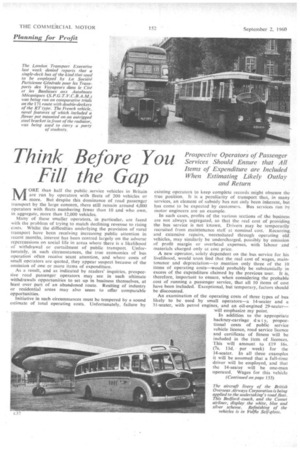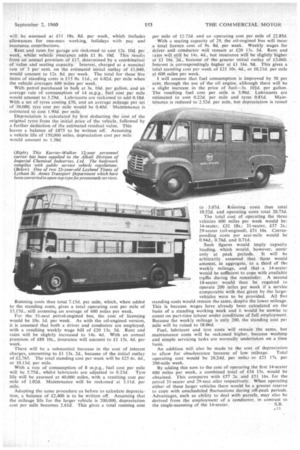Think Before You Fill the Gap
Page 68

Page 71

If you've noticed an error in this article please click here to report it so we can fix it.
MORE than half the public service vehicles in Britain are run by operators with fleets of 200 vehicles or more. But despite this dominance of road passenger transport by the large concern, there still remain around 4,000 operators with fleets numbering fewer than 10 and who own, in aggregate, more than 12,000 vehicles.
Many of these smaller operators, in particular, are faced with the problem of trying to match declining revenue to rising costs. Whilst the difficulties underlying the provision of rural transport have been receiving increasing public attention in recent months, interest has been centred. largely on the adverse repercussions on social life in areas where there is a likelihood of withdrawal or curtailment of public transport. Unfortunately, in such circumstances, the true economics of bus operatiori often receive scant attention, and where costs of small operators are quoted, they appear suspect because of the omission of one or more items of expenditure.
As a result, and as indicated by readers' inquiries, prospective road passenger operators may see in such ultimate withdrawals opportunities to set up in business themselves, at least over part of an abandoned route. Resiting of industry or residential areas may also seem to offer comparable opportunities.
Initiative in such circumstances must be tempered by a sound estimate of total operating costs. Unfortunately, failure by existing operators to keep complete records might obscure the true position. It is n peculiarity of transport that, in many services, an element of subsidy has not dnly been inherent, but has come to be expected by customers. Bus services run by motor engineers are an example.
In such cases, profits of the various sections of the business are not always segregated, so that the real cost of providing the bus service is not known. Drivers may be temporarily recruited from maintenance staff at nominal cost. Recurring and extensive repairs, necessitated through operating old vehicles, may similarly be undercharged, possibly by omission of profit margin or overhead expenses, with labour and materials charged only at cost price.
A new operator, solely dependent on the bus service for his livelihood, would soon find that the real cost of wages, maintenance and depreciation—to mention only three of the 10 items of operating costs—would probably be substantially in excess of the expenditure claimed by the previous user. It is, therefore, important to ensure, when considering the probable cost of running a passenger service, that all 10 items of cost have been included. Exceptional, but temporary, factors should be discounted.
An examination of the operating costs of three types of bus likely to be used by small operators—a 14-seater and a 31-seater, with petrol engines, and an oil-engined 29-seaterwill emphasize my point.
In addition to the appropriate hackney-carriage d u t y, proportional costs of public service vehicle licence, road service licence and certificate of fitness will be included in the item of licences. This will amount to i19 16s. (7s. lid. • per week) for the 14-seater. In all three examples it will be assumed that a full-time driver will be employed, and that the 14-seater will be one-man operated. Wages for this vehicle
(Continued on page 153)
will be assessed at £11 18s. 8d. per week, which includes allowances for one-man working, holidays with pay and insurance contributions.
Rent and rates for garage are reckoned to cost 12s. 10d. per week, whilst vehicle insurance adds 1. 8s, 10d. This results from an annual premium of £17, determined by a c.ombMation of value and seating capacity. Interest, charged at a nominal rate of 3 per cent, on the estimated -initial outlay of £1,040, would amount to 12s. 8d, per week. The total for these five items of standing costs is £15 Os. 11d., or 6.020. per Mile when the vehicle averages 600 miles per week.
With petrol purchased in bun( at 3s, 10d. per gallon, and an average rate of consumption of 14 m.p.g., fuel cost per mile . .
would amount to 3.29d. Lubricants are reckoned to add 0.18d. With a set of tyres costing £50, and an average mileage per et of 32,000, tyre cost per mile would be 0.400. Maintenance is. .estimated to cost I.90d. per mile.
Depreciation is calculated by first deducting the cost of the original tyres from the initial price of the vehicle, followed by a further deduction of the estimated residual value. This leaves a balance of £875 to be written off. Assuming a vehicle life of 150,000 mites, depreciation cost per mile would amount to 1.38d.
Running costs thus total 7.15d. per mile, which, when added to the standing costs, gives a total operating cost per mile of 13.170., still assnming an average of 600 miles per week.
For the 31-seat petrol-engined bus, the cost of licensing would be 10s. Id. per week. As with the oil-engined version, it is assumed that both a driver and conductor are employed, with a resulting weekly wage bill of £20 13s, 5d.. Rent and rates will be slightly increased to 14s. 40. With an annual premium of £88 10s., insurance will amount to 15s, 40. per week, .
There will be a substantial increase in the cost of interest charges, amounting to LI 13s. 2d., because of the initial outlay of £2,765. The total standing cost per week will be £25 6s. 40., or 10.13d. per mile.
With a rate of consumption of 8 m.p.g., fuel cost per mile will be 5.75d., whilst lubricants are adjusted to 0.23d. Tyre life will be assessed at 40.000 miles, with a resulting cost per mile of 1.02d. Maintenance will be reckoned at 3.11d. per mile.
Adopting the same procedure as before to calculate depreciation, a balance of £2,400 is to be written off. Assuming that the mileage life for the larger vehicle is 200,000, depreciation cost per mile becomes 2.61d. This gives a total running cost
per mile of 12.720. and an operating cost per mile of 22.85d.
With a seating capacity of 29, the oil-engined bus will incur a total licence cost of 9s. 8d. per week. Weekly wages for driver and ccincluctor will remain at £20 13s. 5d. Rent and rates will still be 14s, 40., but insurance will be slightly higher at--£1 16s. 20., because of the greater initial outlay of £3,060. :Interest is correspondingly higher at LI I6s. 9d. This gives a total standing cost per week of £25 10s. 40., or 10.21d. per mile at 600 miles per week.
I will assume that fuel consumption is improved by 50 per cent, through the use of the oil engine, although there will be a. slight increase in the price of fuel-3s. 10.1d, per gallon. The resulting fuel cost per mile is 3.900. Lubricants are estimated to cost 0.22d. per mile and tyres 0.81d. Maintenance is reduced to 2.520. per mile, but depreciation is raised
to 3.07d. Running costs thus total 10.52d. and operating costs total 20.73d.
The total cost of operating the three vehicles 600 miles per week would be: 14-seater, £32 18s.; 31-seater, £57 2s.: 29-seater (oil-engined), £51 16s. Corresponding costs per seat-mile would be 0.940., 0.760. and 0.710.
Such figures would imply capacity loading, which would, however, occur only at peak periods. It will be arbitrarily, assumed that these would amount, in aggregate, to a third of the weekly mileage, and that a 14-seater would be sufficient to cope with available tro.ffic during the remainder. A second 14-seater, would then be required to operate 200 miles per week if a service comparable with that given by the larger vehicles were to be provided. All five standing costs would remain the same, despite the lower mileage. This is because wages have already been calculated on the basis of a standing working week and it would be unwise to count on part-time labour under conditions of full employment. Because the weekly mileage is only 200, the standing cost per mile will be raised to 18.060.
Fuel, lubricant and tyre 'costs will remain the same, but maintenance costs will be reckoned higher, because washing and simple servicing tasks are normally undertaken on a time basis.
An addition will also be made to the cost of depreciation to allow for obsolescence because of low mileage. Total operating cost would be 26.24d. per mile, or £21 17s. per 200-mile week.
By adding this sum to the cost of operating the first 14-seater 600 miles per week, a combined total of £54 15s. would be obtained. This compares with £57 2s. and £51 16s. for the petrol 31-seater and 29-seat oiler respectively. When operating either of these larger vehicles there would be a greater reserve to cope with unscheduled fluctuations during off-peak periods. Advantages, such as ability to deal with parcels, may also be derived from the employment of a conductor, in contrast to the single-manning of the 14-seater. ' S.D.








































































































